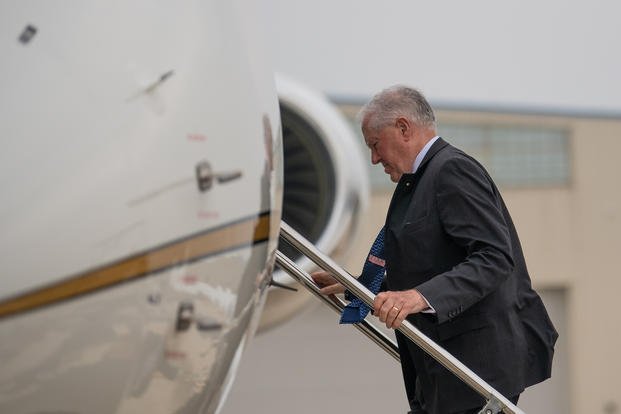
The Department of the Air Force‘s ambitious reorganization plan designed to keep the Air Force and Space Force competitive against China was unveiled earlier this year, listing 24 items ranging from bringing back warrant officers and reorganizing training to creating new offices and elevating new commands.
Some of those changes are underway, but others haven’t been touched yet. Now, lawmakers, government watchdogs and defense policy experts are raising alarm that all of those plans could easily be upended by the upcoming presidential election.
The service’s plan was released in February, but a month later Congress stepped in and commissioned the Government Accountability Office — the lawmakers’ watchdog agency — to provide its take on the scheme. On Thursday, the GAO delivered its findings. The report isn’t public for now, having been deemed Controlled Unclassified Information — meaning it is not classified but is still hidden from view.
Read Next: Judge Dismisses Case Against Man Accused of Shooting at Military Helicopters. Here’s Why
While Diana Maurer, a director in GAO’s Defense Capabilities and Management team, did not delve into the specifics of the findings in an interview with Military.com, she explained that Department of the Air Force Secretary Kendall’s understandable push to reorganize the Air Force and Space Force for the threat of China may not have staying power long after November.
“I give them credit for taking that on as an initiative, and I think the secretary’s sense of urgency on this is understandable,” Maurer said. “The proof is going to be in the pudding about where these initiatives are going to be in six months, 12 months, 24 months, right?”
And during that window, the White House residence will have a new tenant.
“Obviously, there’s an election in a month and a half now that’s going to play a big role in a lot of this,” she said.
Kendall unveiled his 24 initiatives related to what he dubbed “reoptimizing for great power competition” with a speech in February, stating, “We are moving forward with a sense of urgency to ensure we are ready to deter and, if necessary, win. We are out of time.”
The Air Force secretary also mentioned earlier this year that the changes were created to “minimize cost,” but said there’s nothing in the 2024 or 2025 budget to assist with the new strategies and offices. He added that the plan might require funding in 2026.
Many of the 24 steps are aimed at cutting through bureaucracy or combining alike offices, such as putting a lot of similar training missions under a new Airman Development Command, or creating a department-level Office of Competitive Activities and a Space Futures Command to oversee sensitive projects or conduct experimentation, according to the service.
While many are highly technical and focused on acquisitions, some of the personnel changes, like bringing back warrant officers for the first time in more than six decades, were widely praised among the enlisted.
But doubts seemingly persist among some lawmakers about the reorganization plan. Rep. Ken Calvert, R-Calif., who chairs the defense appropriations subcommittee and is a member of the Air Force caucus, told Military.com in an emailed statement that questions about cost and staying power are still on his mind.
“Some areas of the Air Force’s reorganization concept are better defined than others,” Calvert said. “I have yet to see exact plans matched with realistic cost estimates. I appreciate Secretary Kendall’s intent to reoptimize the service, but am wary of reorganization for its own sake when long-term effects and costs are unclear.”
Kendall, during a speech at the Air and Space Forces Association’s biannual conference just outside of Washington, D.C., last week, mentioned the upcoming presidential election and said he hopes that, no matter who takes the White House in November, he can remain in his role.
“My hope is that I will have the opportunity to continue to serve but, if not, you can be certain that I will be working as hard as I can for as long as I can to prepare the Department of the Air Force for a conflict that is not inevitable, but may be becoming more likely over time,” he said in his remarks.
Kendall added that “progress on the 24 decisions that we announced is that all of the actions required are well underway,” adding that “a few are slightly late to the original schedule, but overall progress is excellent and nothing is far enough off track to cause major concern.”
During a media roundtable after Kendall’s speech, Military.com asked him whether he was worried about a new commander in chief derailing the Department of the Air Force’s ambitious plans.
“I’m not worried about that,” Kendall replied. “The things we’re doing, I think, are pretty logical. They’re aligned with what our needs are relative to the threat. There’s been no real pushback from the Congress on any of them.”
Air Force Chief of Staff Gen. David Allvin, the service’s top military leader, told Military.com during a separate media roundtable at the Air and Space Forces Association’s conference last week, that he felt Congress has been increasingly buying into the ideas since the initial rollout earlier this year.
“I think we maneuvered from the point of February when we rolled out all those and there was mild skepticism, because it just seemed like a list of things,” Allvin said. “I think they moved from mild skepticism to genuine interest.”
Todd Harrison, a senior fellow at the American Enterprise Institute focused on defense strategy, budgeting and space policy, told Military.com in an interview that the plan is a key policy that Kendall has personally pushed and, following November, it’s likely it won’t continue to have steam if he’s no longer the secretary of the Air Force.
“I would say the overall plan is very much tied to Kendall, so I think it is doubtful that it will survive intact if there’s a transition to a different secretary of the Air Force,” Harrison said. “And regardless of how the election goes, I think it’s to be expected that, when there’s a new president, that there will be a turnover in just about every senior presidentially appointed position.”
Harrison added that Kendall’s chances of staying on in a potential role under Vice President Kamala Harris seem like a “small probability,” and under a potential second term for former President Donald Trump, there is “zero chance.”
With no budget allocated already for the plan, it’s really up to the next secretary, Harrison said.
“If he wanted to get this done, the clock has kind of run out on doing that,” Harrison added.
— Rebecca Kheel contributed to this report.
Related: Air Force Overhaul Plan that Brings Back Warrant Officers Draws Scrutiny from Capitol Hill






